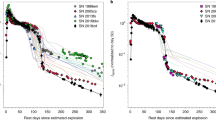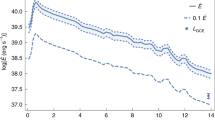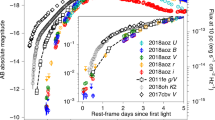Abstract
It is widely believed that asphericity in the explosion is the crucial ingredient leading to successful core-collapse (CC) supernovae. However, direct observational evidence for the explosion geometry and for the connection with the progenitor properties are still missing. Based on the thus-far largest late-phase spectroscopic sample of stripped-envelope CC supernovae, we demonstrate that about half of the explosions exhibit a substantial deviation from sphericity. For these aspherical CC supernovae, the spatial distributions of the oxygen-burning ash and the unburnt oxygen, as traced by the profiles of [Ca ii] λλ7291,7323 and [O i] λλ6300,6363 emissions, respectively, appear to be anticorrelated, which can be explained if the explosion is bipolar and the oxygen-rich material burnt into two detached iron-rich bubbles. Our combined analysis of the explosion geometry and the progenitor mass further suggests that the degree of asphericity grows with the mass of the carbon–oxygen core, which may be used to guide state-of-the-art simulations of CC supernova explosions.
This is a preview of subscription content, access via your institution
Access options
Access Nature and 54 other Nature Portfolio journals
Get Nature+, our best-value online-access subscription
$29.99 / 30 days
cancel any time
Subscribe to this journal
Receive 12 digital issues and online access to articles
$119.00 per year
only $9.92 per issue
Buy this article
- Purchase on Springer Link
- Instant access to full article PDF
Prices may be subject to local taxes which are calculated during checkout




Similar content being viewed by others
Data availability
Most of the spectra are available from WiseRep (https://www.wiserep.org/) and Supernova Database of Berkeley (http://heracles.astro.berkeley.edu/sndb/). The data that support the plots within this paper and other findings of this study are available from the corresponding author upon reasonable request.
Code availability
Astropy, Matplotlib, Numpy and Scipy are available from the Python Package Index (PyPI) (https://pypi.org/). Upon request, the first author will provide the Python code used to generate the model line profiles.
References
Khokhlov, A. M. et al. Jet-induced explosions of core collapse supernovae. Astrophys. J. Lett. 524, L107–L110 (1997).
Wang, L. et al. Bipolar supernova explosions. Astrophys. J. Lett. 550, 1030–1035 (2001).
Maeda, K. & Nomoto, K. Bipolar supernova explosions: nucleosynthesis and implications for abundances in extremely metal-poor stars. Astrophys. J. 598, 1163–1200 (2003).
Maeda, K., Nomoto, K., Mazzali, P. A. & Deng, J. Nebular spectra of SN 1998bw revisited: detailed study by one- and two-dimensional models. Astrophys. J. 640, 854–877 (2006).
Woosley, S. E. & Bloom, J. S. The supernova gamma-ray burst connection. Annu. Rev. Astron. Astrophys. 44, 507–556 (2006).
Nomoto, K. I., Iwamoto, K. & Suzuki, T. The evolution and explosion of massive binary stars and type Ib-Ic-IIb-IIL supernovae. Phys. Rep. 256, 173–191 (1995).
Mazzali, P. A. et al. An asymmetric energetic type Ic supernova viewed off-axis, and a link to gamma ray bursts. Sci. 308, 1284–1287 (2005).
Maeda, K. et al. Explosive nucleosynthesis in aspherical hypernova explosions and late-time spectra of SN 1998bw. Astrophys. J. 565, 405–412 (2002).
Maeda, K. et al. Asphericity in supernova explosions from late-time spectroscopy. Sci. 319, 1220- (2008).
Modjaz, M. et al. Double-peaked oxygen lines are not rare in nebular spectra of core-collapse supernovae. Astrophys. J. Lett. 687, L9 (2008).
Taubenberger, S. et al. Nebular emission-line profiles of type Ib/c supernovae – probing the ejecta asphericity. Mon. Not. R. Astron. Soc. 397, 677–694 (2009).
Milisavljevic, D. et al. Doublets and double peaks: late-time [O i] λλ6300,6364 line profiles of stripped-envelope, core-collapse supernovae. Astrophys. J. 709, 1343–1355 (2010).
Fang, Q. et al. Statistical properties of the nebular spectra of 103 stripped-envelope core-collapse supernovae. Astrophys. J. 928, 151 (2022).
Jerkstrand, A. in The Handbook of Supernovae (eds Alsabti, A. W. & Murdin, P.) 795–842 (Springer International Publishing, 2017).
Dessart, L. et al. Nebular phase properties of supernova Ibc from He-star explosions. Astron. Astrophys. 656, A61 (2021).
Prentice, S. J. et al. Oxygen and calcium nebular emission line relationships in core-collapse supernovae and Ca-rich transients. Mon. Not. R. Astron. Soc. 514, 5686–5705 (2022).
van Baal, B. F. A. et al. Modelling supernova nebular lines in 3D with EXTRASS. Mon. Not. R. Astron. Soc. 523, 954 (2023).
Maurer, J. I. et al. Characteristic velocities of stripped-envelope core-collapse supernova cores. Mon. Not. R. Astron. Soc. 402, 161–172 (2010).
Fransson, C. & Chevalier, R. A. Late emission from supernovae – a window on stellar nucleosynthesis. Astrophys. J. 343, 323 (1989).
Jerkstrand, A. et al. Late-time spectral line formation in type IIb supernovae, with application to SN 1993J, SN 2008ax, and SN 2011dh. Astron. Astrophys. 573, A12 (2015).
Kuncarayakti, H. et al. Nebular phase observations of the type-Ib supernova iPTF13bvn favour a binary progenitor. Astron. Astrophys. 579, A95 (2015).
Fang, Q. et al. A hybrid envelope-stripping mechanism for massive stars from supernova nebular spectroscopy. Nat. Astron. 3, 434–439 (2019).
Dessart, L. et al. Modeling of the nebular-phase spectral evolution of stripped-envelope supernovae. New grids from 100 to 450 days. Astron. Astrophys. 677, A7 (2023).
Fang, Q. & Maeda, K. Inferring the progenitor mass–kinetic energy relation of stripped-envelope core-collapse supernovae from nebular spectroscopy. Astrophys. J. 949, 93 (2023).
Nakamura, K. et al. Systematic features of axisymmetric neutrino-driven core-collapse supernova models in multiple progenitors. Publ. Astron. Soc. Jpn 67, 107 (2015).
Woosley, S. E., Heger, A. & Weaver, T. A. The evolution and explosion of massive stars. Rev. Mod. Phys. 74, 1015–1071 (2002).
Limongi, M. & Chieffi, A. Evolution, explosion, and nucleosynthesis of core-collapse supernovae. Astrophys. J. 592, 404–433 (2003).
Benjamin, D. J. et al. Redefine statistical significance. Nat. Hum. Behav. 2, 6–10 (2018).
Burrows, A. & Vartanyan, D. Core-collapse supernova explosion theory. Nature 589, 29–39 (2021).
Blondin, J. M., Mezzacappa, A. & DeMarino, C. Stability of standing accretion shocks, with an eye toward core-collapse supernovae. Astrophys. J. 584, 971 (2003).
Fernández, R. Three-dimensional simulations of SASI- and convection-dominated core-collapse supernovae. Mon. Not. R. Astron. Soc. 452, 2071 (2015).
Matsumoto, J. et al. 2D numerical study for magnetic field dependence of neutrino-driven core-collapse supernova models. Mon. Not. R. Astron. Soc. 499, 4174–4194 (2020).
Varma, V., Müller, B. & Schneider, F. R. N. 3D simulations of strongly magnetized non-rotating supernovae: explosion dynamics and remnant properties. Mon. Not. R. Astron. Soc. 518, 3622–3636 (2023).
Reichert, M. et al. Magnetorotational supernovae: a nucleosynthetic analysis of sophisticated 3D models. Mon. Not. R. Astron. Soc. 518, 1557–1583 (2023).
Shivvers, I. et al. The Berkeley sample of stripped-envelope supernovae. Mon. Not. R. Astron. Soc. 482, 1545–1556 (2019).
Yaron, O. & Gal-Yam, A. WISeREP – an interactive supernova data repository. Publ. Astron. Soc. Pac. 124, 668–681 (2012).
Galama, T. J. et al. An unusual supernova in the error box of the γ-ray burst of 25 April 1998. Nature 395, 670–672 (1998).
Iwamoto, K. et al. A hypernova model for the supernova associated with the γ-ray burst of 25 April 1998. Nature 395, 672–674 (1998).
Pian, E. et al. An optical supernova associated with the X-ray flash XRF 060218. Nature 442, 1011–1013 (2006).
Mazzali, P. A. et al. A neutron-star-driven X-ray flash associated with supernova SN 2006aj. Nature 442, 1018–1020 (2006).
Milisavljevic, D. et al. The broad-lined type Ic SN 2012ap and the nature of relativistic supernovae lacking a gamma-ray burst detection. Astrophys. J. 799, 51 (2015).
Chakraborti, S. et al. A missing-link in the supernova-GRB connection: the case of SN 2012ap. Astrophys. J. 805, 187 (2015).
Maeda, K. et al. The unique type Ib supernova 2005bf at nebular phases: a possible birth event of a strongly magnetized neutron star. Astrophys. J. 666, 1069–1082 (2007).
Makarov, D. et al. HyperLEDA. III. The catalogue of extragalactic distances. Astron. Astrophys. 570, A13 (2014).
Fang, Q. & Maeda, K. The origin of the Ha-like structure in nebular spectra of type IIb supernovae. Astrophys. J. 864, 47 (2018).
Jerkstrand, A. et al. Constraints on explosive silicon burning in core-collapse supernovae from measured Ni/Fe ratios. Astrophys. J. 807, 110 (2015).
Jerkstrand, A. et al. Supersolar Ni/Fe production in the type IIp SN 2012ec. Mon. Not. R. Astron. Soc. 448, 2482–2494 (2015).
Dong, S. et al. Type Ia supernovae with bimodal explosions are common – possible smoking gun for direct collisions of white dwarfs. Mon. Not. R. Astron. Soc. 454, L61 (2015).
Patat, F. et al. The metamorphosis of SN 1998bw. Astrophys. J. 555, 900 (2001).
Maeda, K. et al. SN 2006aj associated with XRF 060218 at late phases: nucleosynthesis signature of a neutron star-driven explosion. Astrophys. J. Lett. 658, L5–L8 (2007).
Acknowledgements
We thank J. Jiang, S. Mattila and A. Jerkstrand for reviewing the presubmission manuscript and providing a number of constructive suggestions. Q.F. acknowledges support from the Japan Society for the Promotion of Science (JSPS) through KAKENHI grant 20J23342. K.M. acknowledges support from JSPS KAKENHI grants JP18H05223, JP20H00174 and JP20H04737. H.K. and T.N. are funded by the Research Council of Finland through projects 324504, 328898 and 353019. This work is supported by the JSPS Open Partnership Bilateral Joint Research Projects between Japan and Finland (K.M. and H.K.; JPJSBP120229923).
Author information
Authors and Affiliations
Contributions
Q.F., K.M. and T.N. initialized the project. Q.F. led the nebular spectroscopy analysis, model construction and the manuscript preparation. K.M. organized the efforts to interpret the results and assisted in manuscript preparation. H.K. and T.N. contributed to the spectroscopy analysis and interpretations. All authors contributed to the discussions and editing the manuscript.
Corresponding authors
Ethics declarations
Competing interests
The authors declare no competing interests.
Peer review
Peer review information
Nature Astronomy thanks Vishnu Varma and the other, anonymous, reviewer(s) for their contribution to the peer review of this work.
Additional information
Publisher’s note Springer Nature remains neutral with regard to jurisdictional claims in published maps and institutional affiliations.
Supplementary information
Supplementary Information
Supplementary Table 1, Figs. 1–6 and refs. 1–27.
Rights and permissions
Springer Nature or its licensor (e.g. a society or other partner) holds exclusive rights to this article under a publishing agreement with the author(s) or other rightsholder(s); author self-archiving of the accepted manuscript version of this article is solely governed by the terms of such publishing agreement and applicable law.
About this article
Cite this article
Fang, Q., Maeda, K., Kuncarayakti, H. et al. An aspherical distribution for the explosive burning ash of core-collapse supernovae. Nat Astron 8, 111–118 (2024). https://doi.org/10.1038/s41550-023-02120-8
Received:
Accepted:
Published:
Issue Date:
DOI: https://doi.org/10.1038/s41550-023-02120-8



